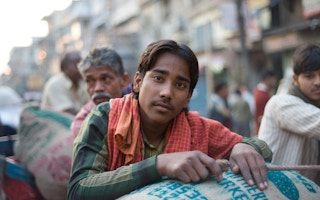In Sumit Bhanwala’s village in northern India, pictures of the Statue of Liberty adorn facades and tractors display stars and stripes bumper stickers - a way to let neighbours know that sons, brothers and nephews have made it to the United States.
For 25-year-old Bhanwala, the images are a source of inspiration as he prepares for an arduous, months-long journey to sneak across the US border - an odyssey that will cost his family tens of thousands of dollars in fees to people smugglers.
“America is the solution. Look around you,” he said, pointing out the modern multistorey houses that have sprung up in the village in Haryana state thanks to remittances sent from migrants already overseas.
He is among a growing number of young Indians - mostly men from the northern states of Punjab and Haryana, and Gujarat in the west - migrating illegally to countries including the United States, Canada and Britain in search of better-paid jobs.
A record 96,917 Indians were caught or expelled last year trying to cross into the United States, up from 30,662 in 2021, according to US Customs and Border Protection. It is not clear how many more managed to cross the border.
Aware of the risk of failure, Bhanwala declined to share details of his journey plan - fearing it could jinx his travels.
Instead, he showed off a new pair of hiking boots, a puffer jacket and a big blue rucksack purchased for the trip, and recounted his reasons for deciding to go.
“I’ve been unemployed for six months … There’s nothing here for me,” Bhanwala, a political science graduate, told Context at his home in Dhatrath, which lies some 150 km (93 miles) from the capital, New Delhi.
Bhanwala wanted to be a policeman, but gave up after question papers for a recruitment exam in 2021 were leaked to other candidates - dampening his hopes of success.
“I lost all faith in the recruitment process, and thought ‘enough is enough’,” said Bhanwala, whose father sold the family’s farmland and borrowed money from a loan shark to pay a people smuggler 5 million rupees (US$60,175) for the trip.
“
People are trying to find better job prospects wherever they get them … even if that means doing low-end jobs abroad … just for better pay.
Rahul Verma, fellow, Centre for Policy Research
In interviews with 32 people in seven Haryana villages, most cited unemployment and a lack of skilled, well-paid jobs as the motive driving hundreds of men to leave via the “donkey” route - a long, roundabout journey designed to dodge border controls.
India’s unemployment rate has been steadily falling since 2018, but rural joblessness remains a problem - especially among the young. Both joblessness and underemployment are a key concern for authorities ahead of a general election due by May.
The number of Indians betting it all to migrate to wealthy countries is as much about aspiration as fleeing poverty, migration experts say.
“People are trying to find better job prospects wherever they get them … even if that means doing low-end jobs abroad … just for better pay,” said Rahul Verma, a fellow at New Delhi-based Centre for Policy Research (CPR).
The federal labour ministry did not respond to requests for comment.
Risk and reward
The “donkey” route has been an open secret in Punjab for more than a decade.
The term originates from the Punjabi word “dunki”, meaning to “hop from place to place”, and is also depicted in the eponymous Hindi film starring Bollywood icon Shah Rukh Khan.
The “donkey” practice made international headlines in December when France grounded a charter flight, which was carrying 303 Indian passengers from Dubai to Nicaragua, on suspicions of people smuggling. Most were sent back to India.
People traffickers often take migrants from New Delhi and Mumbai to the United Arab Emirates on tourist visas.
Then they go through as many as a dozen transit points in Latin America such as Venezuela, Nicaragua and Guatemala to reach the US-Mexico border, according to families of men who had recently completed their “donkey” journeys.
Once at the border, handlers supply them with fake backstories - in case they get caught while crossing - to make asylum claims on grounds ranging from economic hardship to persecution over religious or LGBTQ+ identity.
A spokesperson for US Customs and Border Protection said the overall number of would-be immigrants being caught or denied entry continues to fluctuate “as smugglers and bad actors continue to spread falsehoods and show complete disregard for the safety and wellbeing of vulnerable migrants”.
Such immigration is also known as the “number two” route, the “number one” being the legal way, which villagers and migrant rights campaigners said was nearly impossible to pursue due to visa rejections or backlogs.
US visa services are still attempting to clear a backlog after Washington halted almost all visa processing worldwide in March 2020 due to the Covid-19 pandemic.
Indian applicants for visas - including those pursuing tech jobs in the United States - have seen wait times for an appointment of over a year in some cases, though delays fell sharply in 2023 when a record 1.4 million visas were processed, according to the US Embassy and Consulates in India.
But the visa backlogs seen in recent years may have spurred some would-be migrants to take the “donkey” route instead.
“We’re leaving these people with no other ways of trying to pursue economic prosperity or safety, in a sense,” said Mario Montoya of Aliento, a Phoenix-based immigrant advocacy group.










